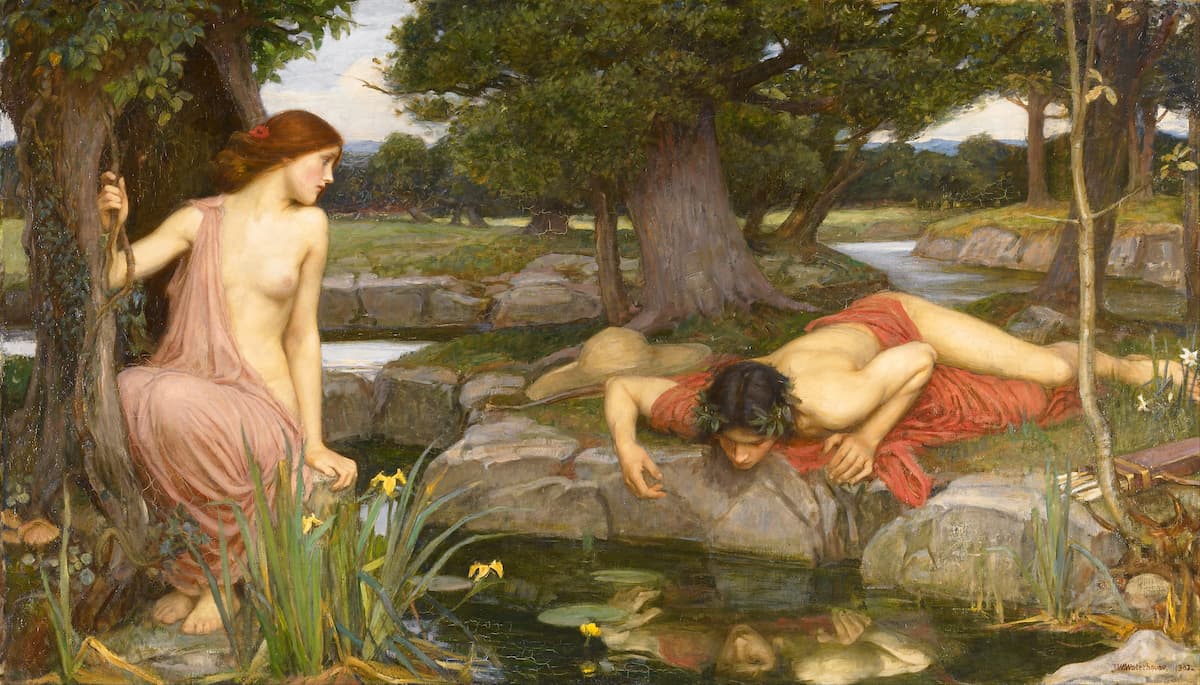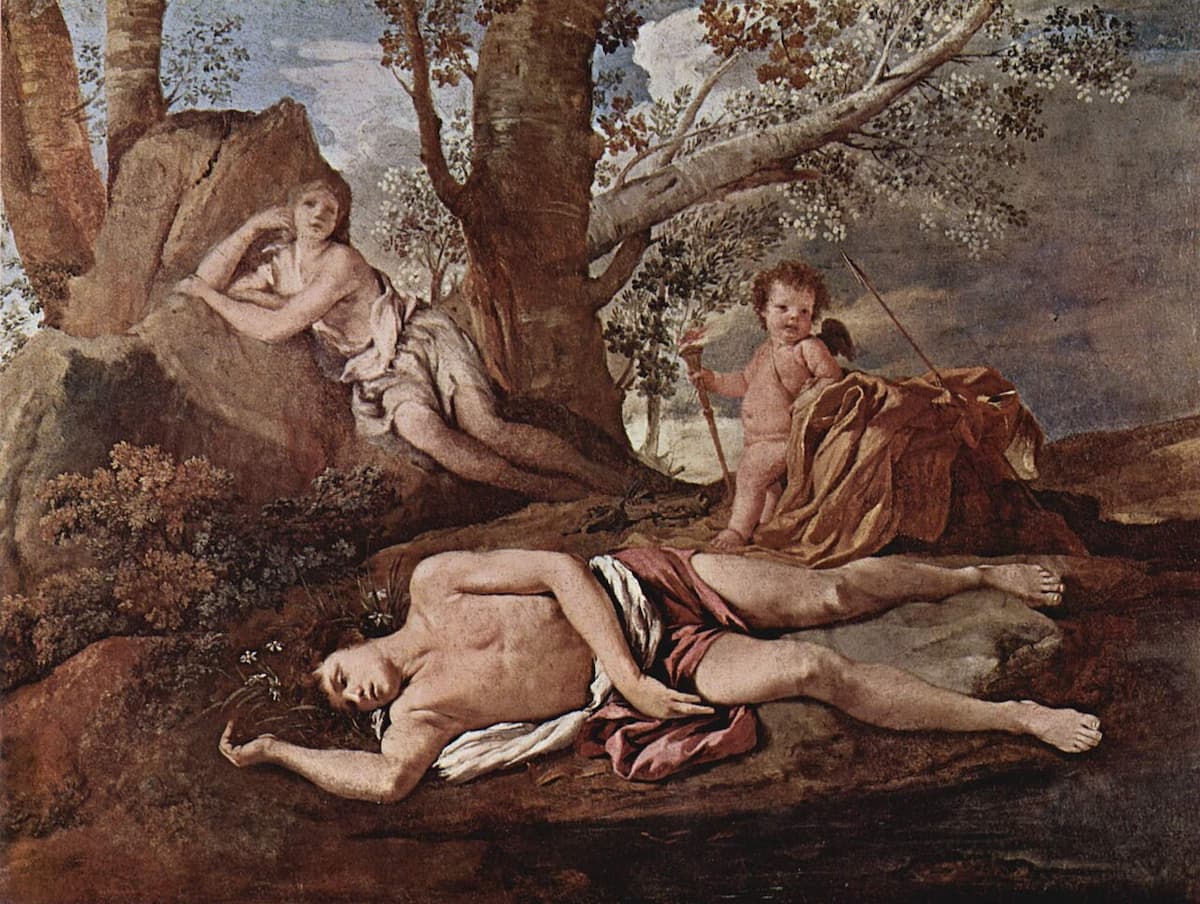Poor Echo. In Greek mythology, she was a nymph who came to the attention of Zeus and then of Zeus’ wife, Hera. Finding her husband in a compromising position and delayed in her discovery by Echo’s long conversations, Hera condemned Echo to only being able to repeat the last words that had been spoken to her….to her. Echo fell in love with Narcissus and as she could only respond to his last words, all went badly. Instead of falling in love with Echo, Narcissus fell in love with himself, and Echo could only mourn over him. All that remains of Echo today is her voice…her voice.

John William Waterhouse: Echo and Narcissus, 1903 (Liverpool, Walker Art Gallery)
As a potential musical topic, Echo comes out in a variety of ways.
In his Echo fantasia, Jan Sweelinck (1562–1621) uses the echo effect of different octaves to accomplish his echo effect. On a larger harpsichord, this could be done with the different keyboards linked in parallel, but it was playable with the simple one-manual harpsichord as well.
Jan Pieterszoon Sweelinck: Echo fantasia in Ionian mode, SwWV 253 (Glen Wilson, harpsichord)
As part of his Concierto de ‘Dance Hits from 1998, American composer Aaron Jay Kernis (b. 1960) takes two movements from his 1993 exploration of pop music in a classical structure, 100 Dance Hits, and remakes them for amplified solo guitar and chamber orchestra. ‘Double Echo’ plays the amplified guitar against the spreading echoes of the chamber orchestra – it’s less a direct echo than watching the effect of a stone in water.
Aaron Jay Kernis: Concierto de “Dance Hits” – I. Double Echo (David Tanenbaum, guitar; New Century Chamber Orchestra; Aaron Jay Kernis, cond.)

Nicolas Poussin: Écho et Narcisse, ca. 1629–1630 (Paris: Louvre)
Even J.S. Bach got into the echo mode. In his Overture in the French Style, BWV 831, the last movement (after all the courantes, gavottes, passepieds, sarabandes, boureées, and gigues) is called simple ‘echo’. The work is for 2-manual harpsichord and uses the double keyboards for the echo effect.
J.S. Bach: Overture (Partita) in the French Style in B Minor, BWV 831 – VIII. Echo (Alessandra Artifoni, harpsichord)
We don’t often think of Dimitri Shostakovich and Britten together, but it was through the cellist and pianist Mstislav Rostropovich that the two composers met and became friends. It was for Rostropovich and his wife, the soprano Galina Vishnevskaya, that Britten took the words of Alexander Pushkin to write The Poet’s Echo. In this arrangement, made by the cellist and the pianist, the former piano part is split between the piano and the cello. The text considers that without the sounds of nature, the poet can only be silent.
Benjamin Britten: The Poet’s Echo (‘Ekho Po’eta), Op. 76 (arr. J. Freeman and A. Hyde-Smith for voice, cello and piano) – No. 1. ‘Ekho (Echo) Gemma Summerfield, soprano; Abi Hyde-Smith, cello; Jocelyn Freeman, piano)
In his song-cycle Echo, which sets the poetry of Emily Dickinson, David Harsent, Philip Larkin, Christina Rossetti, William Butler Yeats, Welsh composer Huw Watkins opens with Christina Rossetti’s poem ‘Echo’. Watkins uses the idea of echo to show how the reflections of a sound can give the original sound a more depth of meaning. For Rossetti, echoes come in the dark silence of night, bringing back memories and hope, but, in the end, are only parts of dreams.
Huw Watkins: Echo – No. 1. Echo (Ruby Hughes, soprano; Huw Watkins, piano)
British composer Oliver Davis (b. 1974) started with the music for what would become Narcissus and Echo, and then gave the music to Simon Littlefield to find the lyrics for it. Littlefield found the story of Narcissus and Echo to make a new song. The setting, for soprano and two boy trebles, conveys all the elements of the story: Echo’s repetitions, Narcissus’ focus on himself, and how his reflection in the pool is yet another echo.
Oliver Davis: Narcissus and Echo (Grace Davidson, soprano; Benedict Moriarty, treble; Sam Brophy, treble; Peacock Ensemble; Budapest Scoring Symphonic Orchestra; Oliver Davis, keyboards; Péter Illényi, cond.)
Another setting of the Narcissus and Echo story comes from Chinese composer Cheng Hui-Hui. The work, which Cheng calls a ‘theatrically enhanced composition’, looks at today’s media environment, which simply echoes and re-echoes the same content. True communication cannot happen when all we do is echo what we’ve just heard. The performance is described as: ‘The two female vocalists combine their natural voices into a duplicate song. Visually, they are kept apart on the stage, and each sings for herself. Electronic sounds duplicate them acoustically in various layers and procedures’.

David Revoy: Narcissus & Echo, 2006–2022
Huihui Cheng: Narcissus and Echo (Silke Evers, soprano; Noa Frenkel, alto; Ensemble Experimental; South West German Radio Experimental Studio; Detlef Heusinger, cond.)
One unique recording of echoes was made by American musician Paul Horn (1930–2014) in 1969 for his album Inside (aka Inside the Taj Majal). The sound made by an unnamed security guard inside the Taj Mahal to show the echoes of the space brings us back to the beauty of sound and re-sound. The call from inside the tombs produces a remarkable 28-record unbroken echo.
Paul Horn: Vibrations
The nymph Echo may have wasted away, mourning the lost love of Narcissus, but she still lives on today for us in canyons and tunnels, sometimes repeating words of beauty and sometimes just noise.
For more of the best in classical music, sign up for our E-Newsletter

